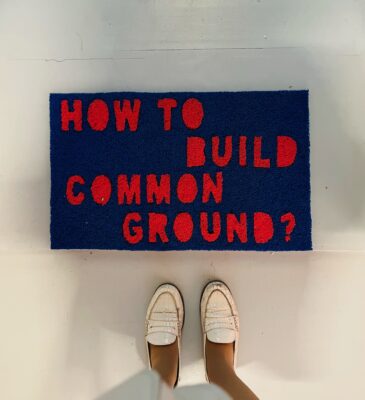Search
To search for an exact match, type the word or phrase you want in quotation marks.
A*DESK has been offering since 2002 contents about criticism and contemporary art. A*DESK has become consolidated thanks to all those who have believed in the project, all those who have followed us, debating, participating and collaborating. Many people have collaborated with A*DESK, and continue to do so. Their efforts, knowledge and belief in the project are what make it grow internationally. At A*DESK we have also generated work for over one hundred professionals in culture, from small collaborations with reviews and classes, to more prolonged and intense collaborations.
At A*DESK we believe in the need for free and universal access to culture and knowledge. We want to carry on being independent, remaining open to more ideas and opinions. If you believe in A*DESK, we need your backing to be able to continue. You can now participate in the project by supporting it. You can choose how much you want to contribute to the project.
You can decide how much you want to bring to the project.

The 12th edition of the MOMENTUM Nordic Biennale is quite special. Together as To Gather is an invitation to meet, to be together. This is the first biennial curated by the Tenthaus collective, a group of artists from Oslo but with diverse cultural backgrounds. Elephant magazine already anticipated it in 2019: “We need collectives more than ever.” The drive to work collaboratively is a defining trait of the 21st century. Artist collectives are not a new phenomenon. A sign of this is that in 2021, the Belfast-based collective Array received the Turner Prize. In the same year, the Indonesian art collective Ruangrupa was named to curate Documenta 15, basing the exhibition on the collective creativity of the Global South.
Collective action has become a trend. The collective counteracts the individualism of a world that has become polarized. Furthermore, institutions are under pressure to address social change. Inclusion, accessibility, sustainability and ethics are concepts incorporated into the new definition of a museum approved in Prague in 2022 by ICOM, the International Confederation of Museums. Social mobilization has been institutionalized.
MOMENTUM 12 presents itself as a place to go beyond divisions to explore what intuitively arises when people, places and times come together. Like other “collectives of collectives” in its desire it wants to democratize hierarchies. For Dag Aak Sveinar, director of MOMENTUM 12 and Galleri F 15, his mission was clear in the last edition of the biennial: “My desire was to make everyone understand that this is a public space.”
MOMENTUM 12 does not disappoint. The spirit of collaboration is welcoming, similar to what it might feel like to walk into a 19th century art community. To arrive at Galleri F15 and the MOMENTUM 12 Biennale at Alby Farm is a declaration of intent. The gallery is located on the island of Jeløy, on the other side of the town of Moss, a spectacular enclave due to its isolation and its great natural beauty under a Nordic sky.
The diversity of cultures, values and perspectives is palpable. The 12th edition includes collaborations with more than 90 artists, collectives and institutions from Norway and the rest of the world. Tenthaus does not seek a unified curatorial point of view but instead a complex polyphony of voices that make up a collective work. It is an evolving biennial. Over the next four months, Together as To Gather will be in constant flux, a process that encourages experimenting with different kinds of togetherness.
The desire to meet and share experiences contradicts the reality. By having a decentralized curatorial approach and being made up of (production, publishing, logistics, hospitality, etc.) bubbles, MOMENTUM 12 was able to have a large number of isolated projects. Can a collective production based only on the idea of bringing people together without a shared purpose, really create a sense of belonging?
At the entrance to one of the rooms of the Galleri F15 there is a doormat that invites you to reflect: How to build common ground? The doormat is at the entrance to Gudhaus (Dugnad), a project of Gudkul, Collective and Contemporary Art Ecosystem Studies, an educational platform formed by three collectives based in Jakarta. In 2015, they joined forces to form a common ecosystem, a collective of collectives with interventions during MOMENTUM 12 in Gudhaus and Gudkitchen. Walking into Gudhaus is like walking into the living room of an Indonesian family. In one corner, there is an unusual chess game. According to Gesyada Siregar, a member of the collective: “Chess invites players to develop strategies of how to create collectives of collectives.” The role of the visitor is not that of a mere spectator, Gesyada points out: “We want everyone to feel like a guest and be welcomed into our home to have an intimate experience.”
This open attitude is in stark contrast to the Wetcation project of the Czech Collective WET. The project is intriguing and subversive. Entering the space exudes danger. It seems like a cabin made from rubble. Stan D’Haene, the curator, explains that in March 2023, WET traveled to Norway from the Czech Republic with the help of alternative means of transport, such as freight trains, hitchhiking, walking or ticketless public transport. The result of situations that arose during the trip formulates the artistic reflections. The installation includes texts, drawings, tattoos, murals and a video that immerses the viewer in the experience of the trip, a fresh narrative inspired by water and in opposition to the practice of graffiti. One of the artists who prefers remain anonymous confessed: “I didn’t feel any danger. However, we encountered resistance and macho attitudes from graffiti artists who insinuated that this was a man’s job.”
Indeed, the contrasting polyphony of voices creates an effervescent effect accidentally illustrated by the artist Stephanie Lüning’s foam action, Island of Foam – Version # XXV/ Colored Barn, an exhilarating explosion of color that took place at the opening.
Although advocating for a common thread is not the goal of Tenthaus, without that common bond the experience would be that of artists and curators flying solo, together in their respective bubbles. For the collective to go beyond fashion, we need to seriously reflect about the common ground of the collectivity and to transcend inspirational phrases such as Together as To Gather. Together yes, but for what?, shouldn’t we collectively gather our thoughts before we get together?

Cecilia Martín is the arts and culture brand strategist. Cecilia is based in London and has founded the Cultural Connection (CC) network-agency that helps museums, art galleries, biennials, orchestras, auditoriums and universities around the world to break the mold and find new ways to connect with their public. Cecilia is a professor of Communication and Branding in Art for the Master of Contemporary Art of the IL3 at the University of Barcelona.
"A desk is a dangerous place from which to watch the world" (John Le Carré)